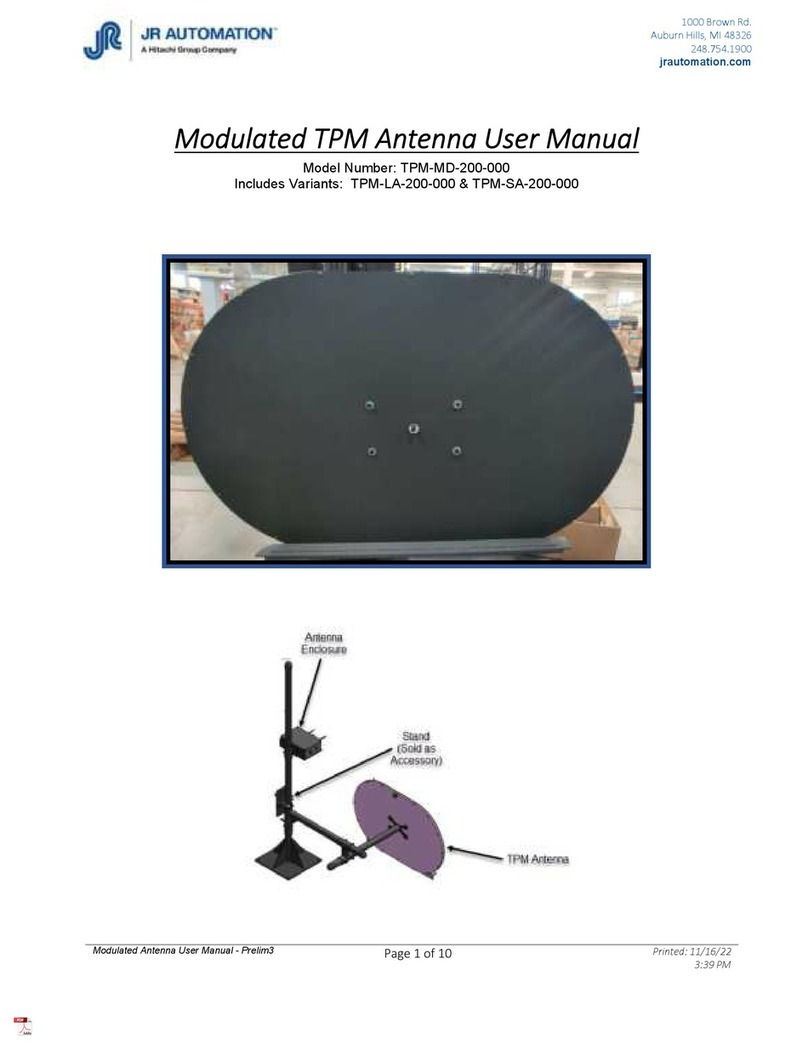
1000 Brown Rd.
Auburn Hills, MI 48326
248.754.1900
jrautomation.com
Continuous Antenna User Manual - Canada
Prelim 1
Page 4 of 11
3:36 PM
SAFETY
1. Only personnel who are properly trained and have adequate knowledge and skill related to this product
should undertake any troubleshooting and repair.
2. It must be assumed at all times that POWER is "ON" so all conditions must be treated as live. This practice
develops a caution that may prevent an accident. Follow posted lockout procedures.
3. REMOVE LOAD from circuit or equipment before and after maintenance/troubleshooting.
4. Equipment—NOTE: Test equipment must be checked at regular intervals.
5. Capacitors MUST be given time to discharge, otherwise it should be done manually with CARE.
6. When troubleshooting "LIVE" equipment, the necessary precautions must be taken as follows:
a. Follow written safe operating practices.
b. MAKE CERTAIN your tools and body are clear of Ground.
c. Use extra PRECAUTION in DAMP areas.
d. BE ALERT and work without any outside distraction.
7. BEFORE applying POWER to any equipment, it must be established without a DOUBT that all persons are
CLEAR.
8. Any CONTROL PANEL DOORS shall be open ONLY when it is necessary to check out the electrical
equipment or wiring. After CLOSING the door, make certain that the disconnecting means is operating
properly with the DISCONNECT HANDLE MECHANISM.
9. ALL COVERS or junction boxes SHOULD be CLOSED before leaving any job.
10. BEFORE STARTING, read and understand all WARNING markings and notices.
11. READ all marking such as nameplates and identification plates.
12. DO NOT alter circuits unless authorized to do so by the manufacturer.
13. DO NOT alter or by-pass protective interlocks.
14. DO NOT place jumper wires across fuses.
15. DO NOT alter over-current protective devices.
16. GROUND connections allow fault currents to flow directly into the ground instead of following through the
body then into the ground. ALL ELECTRICAL APPARATUS MUST BE PROPERLY GROUNDED.
17. Use CAUTION when connecting test equipment probes to test points. SHOCK HAZARDS could exist at the
test points or in the test point area and/or TRANSIENTS induced by the problems could cause a MACHINE
ACTION.
18. AVOID wearing a necklace, ring or chain that is made of a METALLIC substance.
19. All electrical wiring and items related to electrical controls are, and shall always be, in compliance with
current National & Local Regulations.
PERSONAL PROTECTIVE EQUIPMENT
When servicing, protect yourself by wearing protective equipment where required:
1. Safety Glasses—Must be properly fitted and worn when a hazard exists.
2. Gloves—Although it is recommended that gloves not be worn unless absolutely necessary, gloves can
protect the hands from cuts or abrasions caused by slings or sharp edges. Do not use gloves when working
on a tool with rotating equipment.




























